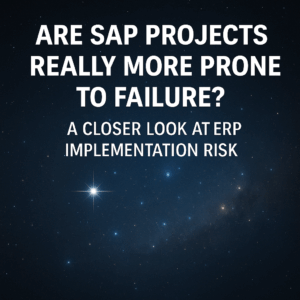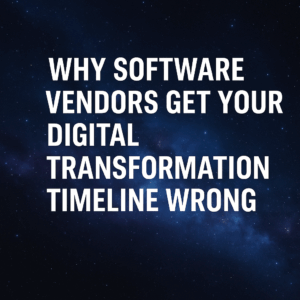Sam Graham
Too many ERP and digital transformation projects fail, and fail unnecessarily. Risk comes from different directions, including:
- consultant selection
- system selection
- a misalignment between software and business strategy
- the company’s own people
- post go-live requirement changes
- lack of previous experience

Taking these in turn; it is perhaps ironic that, whilst companies hire consultants to guide them through their ERP and digital transformation projects, those same consultants come top of the list of risks. The problem is that, when companies employ consultants, they presume them to be offering independent and unbiased advice when, in fact, that may not always be the case because many of them have close relationships with one or other of the big ERP suppliers. They have large teams of consultants trained in their partner’s software so, when approached for advice, they are heavily incentivized to recommend those systems.
The danger is not diminished when companies use smaller consultancies because they can be keen to gain experience of new and bigger systems so, not only will they be learning at their client’s expense, they will on occasion overreach themselves and take on work that they don’t have the skills, experience or resource to do well.
The answer is to break up the consultancy into different aspects and to have different consultants responsible for each of those. So, one consultancy will be asked to help define a digital transformation strategy, to review company requirements, and to help select a system, but that consultancy will have been told upfront that they will not be the implementing consultants; and that has two big advantages.
The first is that it becomes possible to use specialist consultants for this phase, and these specialists can be genuinely independent and unbiased in their recommendations because they can afford to be system agnostic. The second advantage is that, because they work with multiple systems and not just the one supplier, they will not be looking to shoehorn every client into the one same system, regardless of fit. Companies can easily test their consultant’s independence by asking for a list of recent clients and the systems chosen for them. If there is a preponderance of any one (or two) systems on that list, that should be a cause of concern.
Expanding on the theme of system selection, and accepting that specialist consultants can help, it is perhaps surprising that they are not used more widely. One reason, as discussed, is that when companies go straight to selecting a consultancy for the implementation phase, their system has effectively been preselected for them because the consultants are going to recommend the system that has the most benefits for them. As companies come down the scale and look at Tier 2 and Tier 3 systems, there can be a different problem in that the cost of consultancy for the selection phase can appear disproportionate. Justifying a $50,000 consultancy cost on a $100m project is one thing, but even a fraction of that cost on a $1m system can appear to be something that should be avoided if at all possible.
That view is frequently backed up by a belief that there is actually little or no chance of picking a bad system if companies restrict themselves to choosing a system from a large, well-known provider. To an extent, that is true, but it can lead to them buying a system that is too big for their needs, or one that is too inflexible. Further; they can end up spending a lot more money than they expected because, without good advice, they can underestimate the true cost of the project, particularly when salespeople know they are on a set budget and under-quote for consultancy and training knowing that, when true costs emerge mid-project, most companies feel obliged to bite the bullet and plow on rather than pull the plug. Although we said earlier that the first phase (strategy and selection) consultants should not be the implementation consultants, many companies use them during that second phase as sounding boards, and for a reassurance that someone ‘has their back’.
Another thing that experienced consultants can help with is ensuring that the new system, and the way it is implemented, align with business objectives. If a company, when implementing ERP, thinks that they are just replacing their accounting system, then that’s fine. As long as they are not expecting to receive the benefits of a full ERP system or a complete digital transformation. But, if they expect more, they need to know how an ERP system can be used to get them to where they want to be. That means understanding that ERP is not just a computer system; for most companies, it, and an encompassing digital transformation, are an entirely new way of working. If companies don’t understand that, it is the equivalent of buying a Ferrari and never taking it out of first gear. Good, independent consultants can help them understand what ERP can and, just as importantly, can’t do. It may actually be the case that ERP is not the correct answer for what they are trying to do.
A frequently underestimated, or even unidentified, risk comes from the customer’s own project team. The choice of a new system is rarely unanimous and some members can think that the chosen system is not the best for their own department. They may actually be right but have forgotten that the project is about getting the best system for the company and not for individual departments. However; that disappointment can lead to team members trying to get the implementation to fail in the hope that the selection process gets rerun. And, even if the project team is agreed on the selected system, they won’t always agree on how to implement it, or who the project manager should be. Not everyone is a good team player, and although both effective change management and providing ERP education (and not just training) can minimize the problem, a major responsibility of the project sponsor is to ensure that the right people are on the team, and that includes removing people who, for whatever reason, are not performing.
Even when companies do all the right things, and have a successful go-live, success can be short-lived. The only constant in most businesses is changing so, from the first day the system goes live, it and the company will start to drift apart. That means that there is a great advantage to keeping the project team together, even if informally, so that new business requirements and new system functionality can be regularly reviewed.

Finally; it is worth remembering that, nowadays more than ever, companies need to excel in what they do. Manufacturers can excel in manufacturing, distribution companies can excel in distribution etc because that is what they do every day and what they have vast experience of. But implementing ERP is something that they will do perhaps only every ten years or so, often less frequently than that, and a complete digital transformation is something that few will ever have done. So they can’t excel at it without help. The best protection against failure is access to previous experience and the good news is that a lot of useful and valuable advice is actually available, and people who have trodden the path before are frequently happy to help.





